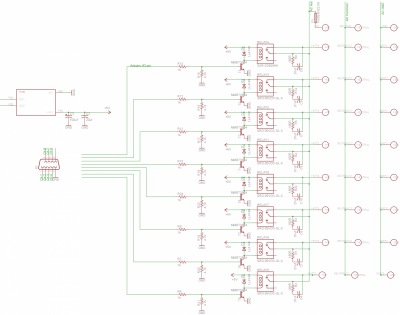Here's an updated AC 120v - 240v power bar I've been working on for Reef-pi. I've been offering these for quite a while and stand behind it but just added a snubber to protect the relays from inductive loads such as motors and added a DB9 socket to match the Reef-pi controller so you only need one cable to controller.
It was designed to be wire free internally, the AC outlets are held firmly in place by a strong 3D printed plate and soldered directly to the board, the 5th image is what you have when its fully assembled. Then it easily drops in the case and is secured with 17 screws overall.
The power bar has an internal 120v - 240v AC-DC module which powers the relays. If Reef-pi is turned off or DB9 is unplugged all outlets turn off.
In the near future I plan to offer a small module that will add an emergency power outage feature. This will plug into the power bar DB9 and have dip switches so you can set each outlet to go to a specific mode if power to controller is lost or DB9 is unplugged. For example you could have outlet 1, 3 and 7 stay on and the remaining turn off. You could also plug something into any outlet and it will only turn on if power goes out or DB9 is unplugged. If you plug the power bar into a UPS you'll have an emergency backup mode for power outages and no need to keep the controller running under battery power.
As you can see this board has North America outlets but soon I will have a version with Australian plugs that work for many countries and another with the large universal outlets to cover the rest. I'm planning to run a Kickstarter soon if any one is interested. If you already have Reef-pi running you can get a DB9 to screw terminals adapter so it would connect easy to your system.
You can also solder wire to the pads on the circuit board and use your own outlets.
I messed up the board so had to put relays on top, I wanted them on the other side of board. Those and the other components will all be on the other side which trim about 14mm off the height of the case. And in the large image the outlets are supposed to be flush with the top but I messed up and ran out of filament, SMH...


It was designed to be wire free internally, the AC outlets are held firmly in place by a strong 3D printed plate and soldered directly to the board, the 5th image is what you have when its fully assembled. Then it easily drops in the case and is secured with 17 screws overall.
The power bar has an internal 120v - 240v AC-DC module which powers the relays. If Reef-pi is turned off or DB9 is unplugged all outlets turn off.
In the near future I plan to offer a small module that will add an emergency power outage feature. This will plug into the power bar DB9 and have dip switches so you can set each outlet to go to a specific mode if power to controller is lost or DB9 is unplugged. For example you could have outlet 1, 3 and 7 stay on and the remaining turn off. You could also plug something into any outlet and it will only turn on if power goes out or DB9 is unplugged. If you plug the power bar into a UPS you'll have an emergency backup mode for power outages and no need to keep the controller running under battery power.
As you can see this board has North America outlets but soon I will have a version with Australian plugs that work for many countries and another with the large universal outlets to cover the rest. I'm planning to run a Kickstarter soon if any one is interested. If you already have Reef-pi running you can get a DB9 to screw terminals adapter so it would connect easy to your system.
You can also solder wire to the pads on the circuit board and use your own outlets.
I messed up the board so had to put relays on top, I wanted them on the other side of board. Those and the other components will all be on the other side which trim about 14mm off the height of the case. And in the large image the outlets are supposed to be flush with the top but I messed up and ran out of filament, SMH...






















